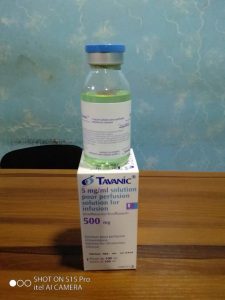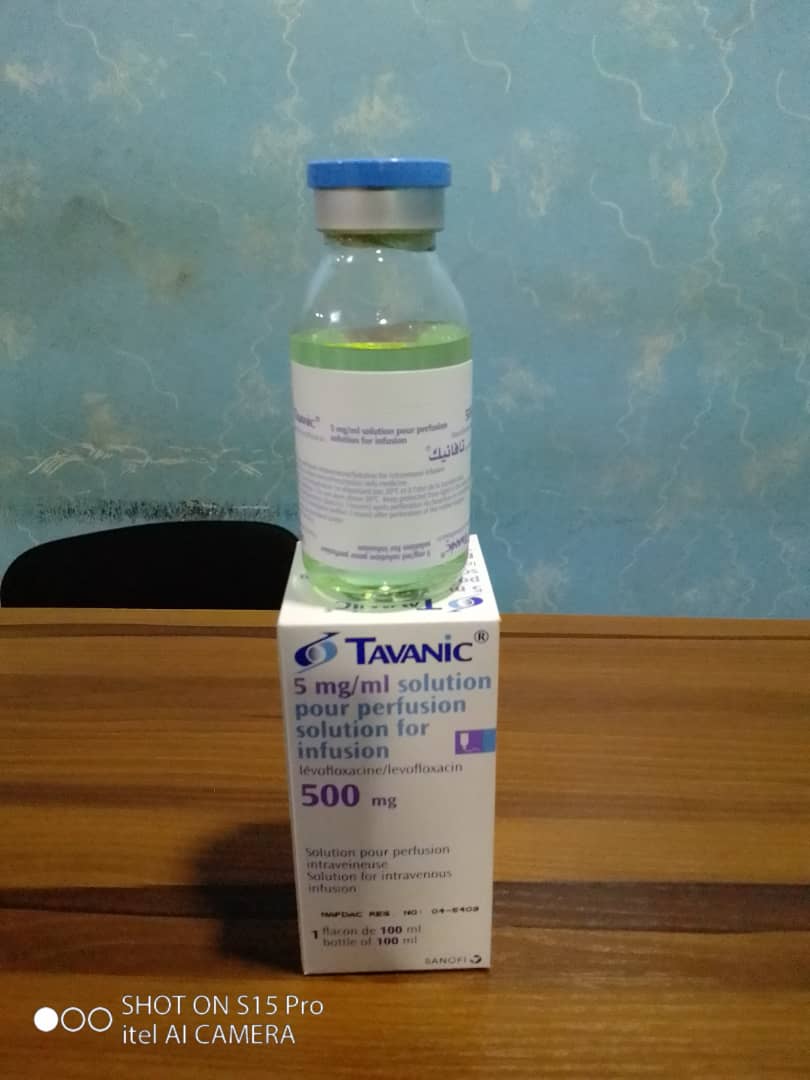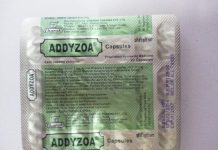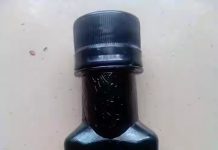Tavanic 500mg : Uses, Dosage, Indications , Contraindications, Generic name, Ingredients, Side Effects, Price.
Generic Name of Tavanic : Levofloxacin
1. WHAT TAVANIC 500mg ARE AND WHAT THEY ARE USED FOR
The name of your medicine is Tavanic contain an active substance known as Levofloxacin. This belongs to a group of active pharmaceutical ingredients called antibiotics. Levofloxacin is a quinolone antibiotic. It works by eliminating bacteria that cause infections in the body.
Tavanic can be used to treat infections of the:
– sinuses,
– bronchi/lungs, in people with long-term breathing problems or pneumonia,
– urinary tract, including the kidneys and bladder,
– prostate, in case of persistent infection,
– skin and subcutaneous tissues, including the muscles. These are sometimes described as ” soft tissues”.
Under specific circumstances, Tavanic can be used to reduce the risk of contracting inhalation anthrax following exposure to anthrax bacteria, or to lower the risk of your condition becoming worse.
2. WHAT YOU NEED TO KNOW BEFORE YOU TAKE TAVANIC
Contraindictions:
Do not take Tavanic and tell your doctor:
– if you are allergic to Levofloxacin, any other quinolone antibiotic such as moxifloxacin, ciprofloxacin or ofloxacin, or any of the other ingredients in this medicine indicated in section 6 below.
Signs of an allergic reaction are: Skin rash, difficulty breathing or swallowing, swelling of the lips, face, throat or tongue.
– if you have or have ever had epilepsy.
– if you have ever had tendon problems, such as tendinitis, related to treatment with quinolone antibiotic. A tendon is a cord that attaches muscle to bone.
– if you are a child or adolescent in the growth phase.
– if you are a child or adolescent in the growth phase.
If you are pregnant, may become pregnant, or think you may be pregnant.
– if you are breast-feeding.
Do not take this medicine if any of the above apply to you. If you are not sure, talk to your doctor or pharmacist before taking Tavanic.
Appropriate precaution for use; special warnings:
Warnings and precautions
Please consult your doctor or pharmacist before taking this medicine:
– if you are 60 years of age or older,
– if you are using corticosteroids, sometimes also called steroids (see section “Other medicines and Tavanic”).
– if you have ever had a seizure,
– if you have had damage to the brain, for example due to a stroke or other brain injury,
– if you have kidney problems,
– if you have a disease known as glucose-6-phosphate-dehydrogenas deficiency. You are more likely to have serious blood problems if you use this medicine.
– if you have or have ever had heart problems. You should use this medicine with caution:
. if you were born with prolonged QT-interval (an anomaly visible on the electrocardiogram (ECG), an electric recording of heart activity), or if one of your relatives had this condition,
. if you have an imbalance of certain blood elements called “electrolytes” (particularly if you have low blood potassium or magnesium levels),
. if you have a very slow heart rate (bradycardia),
. if you have a week heart (heart failure),
. if you have had a heart attach (myocardial infraction),
. if you are a woman or an elderly person or are taking other medicines that cause abnormal ECG changes (also see section “Other medicines and Tavanic”).
– if you are diabetic,
– if you have or have ever had liver problems,
– if you suffer from myasthenia gravis (muscle weakness).
If you are not sure whether any of the above apply to you, talk to your doctor or pharmacist before taking Tavanic.

Other medicines and Tavanic
Tell your doctor or pharmacist if you are taking, have recently taken or intend to take any other medicines. This is because Tavanic may affect the way other medicines work. Also, some medicines may affect the way Tavanic works.
In particular, please tell your doctor if you are taking any of the following medicines. This is because taking these medicines with Tavanic increases the risk of side effects:
– Corticosteroids, sometimes also called steroids – used for inflammation. You may be more likely to have inflammation or rupture of your tendons.
– Warfarin – used to thin the blood. You may be more likely to bleed. Your doctor may ask you to have regular blood tests to check how well your blood clots.
– Theophylline – used for long-term breathing problems. You may be more likely to have a seizure if Tavanic is taken along with this medicine.
– Non-steroidal anti-inflammatory drugs (NSAIDs) such as aspirin, ibuprofen, fenbufen, ketoprofen and indometacin – used for pain and inflammation. You may be more likely to have a seizure if Tavanic is taken along with these medicines.
– Ciclosporin – used after organ transplants, you may be more likely to have Ciclosporin side effects.
– Medicines known to affect the heart rate: drugs for heart rhymthm disorders (anti-arrhythmics such as quinidine, hydroquinidine, disopyramide, amiidarone, sotalol, dofetilide, ibutilide), drugs for depression (tricyclic antidepressants such as amitryptyline and imipramine), drugs for bacterial infections (certain antibiotics of the macrolide group such as erythromycin, azithromycin and clarithromycin), drugs for mental problems (certain antipsychotics).
– Probenecid – used to treat gout. Your doctor may reduce the dose if you have impaired kidney function.
– Cimetidine – used to treat stomach ulcers and heartburn. Your doctor may reduce the dose if you have impaired kidney function.
Tell your doctor if any of the above applies to you.
Do not take Tavanic at the same time as the following medicines. This is because they can affect the way Tavanic work:
– Iron tablets (anemia), zinc preparations, magnesium or aluminum-containing antacids (for heartburn), didanosine or sucralfate (for stomach ulcers)bsee section 3 below. “If you are already talking iron tablets, zinc preparations, antacids, didanosine or sucralfate”.
Urine tests for opiates
In people taking Tavanic, urine tests to screen for strong painkillers known as opiates may produce “false positive” results. If you need to take a urine test, please tell your doctor that you are currently taking Tavanic.
Tuberculosis test
This medicine may result in “false negative” results in specific tests to screen for tuberculosis.
Pregnancy and breast-feeding
Do not use this medicine:
– if you are pregnant, may become pregnant, or think you may be pregnant,
– if you are breast-feeding or intend to breaat-feed.
Driving and using machines
You may have side effects when taking this medicine, including sluggishness, drowsiness, dizziness, or changes to your eyesight. Some of these side effects may affect your ability to concentrate and your reaction speed. If this happens, you must not drive or carry out any activities that require a high degree if concentration.
3. HOW TO TAKE TAVANIC
Always take this medicine exactly as your doctor has told you. You should consult your doctor or pharmacist if you are unsure of anything.
Taking Tavanic
– Take the tablets by mouth.
– Swallow the tablets whole with enough water.
– The tablets can be taken at meal times or at any time between meals.
If you are already taking iron tablets, zinc preparations, antacids, didanosine or sucralfate:
– you must not take Tavanic at the same time as these medicines. Take your dose of these medicines at least 2 hours before or after taking Tavanic.
How many tablets to take
– Your doctor will decide how many Tavanic you need to take.
– The dose will depend on the type of infection you have and where the infection is in your body.
– The duration of treatment will depend on how serious your infection is.
– If you feel that your medicine has too strong or too weak an effect, you must not change the dose yourself, but ask your doctor.
Adults and elderly people
Infection of the sinuses:
– 2 film-coated tablets of Tavanic 250 mg, once daily,
– or 1 film-coated tablet of Tavanic 500 mg, once daily.
Infections of bronchi in patients with long-term breathing problems:
– 2 film-coated tablets of Tavanic 250 mg, once daily, or 1 film-coated tablets of Tavanic 500 mg, once daily.
Pneumonia:
– 2 film-coated tablets of Tavanic 250 mg, once or twice daily,
– or 1 film-coated tablets of Tavanic 500 mg, once or twice daily.
Infection of the urinary tract including the kidneys and bladder:
– 1 or 2 film-coated tablets if Tavanic 250 mg, once daily,
– or ½ or 1 film-coated tablet if Tavanic 500 mg, once daily.
Infections of the prostate:
– 2 film-coated tablets of Tavanic 250 mg, once daily, or 1 film-coated tablet of Tavanic 500 mg, once daily.
Infections of the skin and tissue under the skin, including muscle:
– 2 film-coated tablets of Tavanic 250 mg, once or twice daily, or 1 film-coated tablet of Tavanic 500 mg, once or twice daily.
Adults and elderly people with impaired kidney function:
Your doctor may need to prescribe you a lower dose.
Children and adolescents:
This medicine must not be used in children and adolescents.
Protect your skin from sunlight:
Keep out of direct sunlight while you are taking this medicine and for 2 days after stopping treatment. This is because the skin becomes considerably more sensitive to sunlight and may burn, prickle or blister severely if you do not take the following precautions:
– Make sure you use a high-factor sun cream.
– Always wear a hat and clothes that cover your arms and legs.
– Avoid artificial UV rays (tanning beds).
If you take more Tavanic than you should:
If you accidentally take more filme-coated tablets than you should, inform a doctor or seek medical advice immediately. Take the pack with you so that the doctor knows what you have taken. The following symptoms may develop: seizures, confusion, dizziness or sluggishness, impaired consciousness, trembling, and heart problems leading to an irregular heartbeat, nausea and stomach problems.
If you forget to take Tavanic:
If you forget to take your tablet, take it as soon as you remember unless it is nearly time for your next dose.
Do not take a double dose to make up for forgotten dose.
If you stop taking Tavanic:
Do not stop taking Tavanic simply because you are feeling better. It is important that you continue treatment as prescribed by your doctor. If you stop taking the tablets too soon, the infection may return, your condition may worsen, or the bacteria may become resistant to the medicine.
If you have any further questions on the use of this medicine, ask your doctor or pharmacist.
4. POSSIBLE SIDE EFFECTS OF TAVANIC
Like all medicines, this medicine can cause side effects, although not everybody gets them. These effects are normally mild or moderate and often disappear after a short time.
Stop taking Tavanic and see a doctor or go to a hospital immediately if you notice the following side effects:
Very rare (affects less than 1 person in 10 000)
– Allergic reactions. These include skin rash, difficulty breathing or swallowing, swelling of the lips, face, throat or tongue.
Stop taking Tavanic and consult a doctor immediately if you notice any of the following serious side effects – you may need urgent medical treatment:
Rare (affects less than 1 person in 1 000)
– Watery diarrhea that can contain traces of blood, possibly with stomach cramps and fever. These could be signs of a severe bowel problem.
– Pain and inflammation of tendons or ligaments with possible tearing. The Achilles tendon is most often affected.
– Seizures.
Very rare (affects less than 1 person in 10 000)
– Burning, prickling, pain or numbness. These may be signs of a disorder known as “neuropathy”.
Not known (cannot be estimated from the available data)
– Severe skin rashes including blistering or peeling of the skin around the lips, eyes, mouth, nose and genitals,
– Loss of appetite, yellow coloring of the skin and eyes, dark-colored urine, itching or tender abdomen. These may be signs of a liver disorder or even potentially fatal progressive liver failure.
If you notice eyesight problems or any other eye disorders while taking Tavanic, you must immediately consult an eye specialist.
Tell your doctor if any of the following side effects get serious or last longer than a few days:
Common (affects less than 1 person in 10)
– Sleep disorders,
– headache, dizziness,
– Feeling sick (nausea, vomiting) and diarrhea,
– Increase in certain liver values found through blood tests.
Uncommon (affects less than 1 person in 100)
– Increase in the number of other bacteria or fungi, Candida fungal infection – which may require treatment,
– Changes in the number of white blood cells (leukocytopenia, eosinophillia), found through blood tests,
– Feeling stressed (anxiety), confusion, nervousness, drowsiness, trembling, dizziness (spinning sensation),
– Shortness of breath (dyspnea),
– Changes in the sense of taste, loss if appetite, upset stomach or indigestion (dyspepsia), pain in the stomach area, bloating or constipation,
– Itching and skin rash, severe itching or urticaria (hives), excessive sweating (hyperhidrosis),
– Joint or mucle pain,
– Abnormal blood test results due to liver disease (increased bilirubin values) or kidney disease (increased creatinine values),
– General weakness.
Rare (affects less than 1 person in 1000)
– Bruising or bleeding easily due to a decrease in the number of blood platelets (thrombocytopenia),
– Low number of white blood cells (neutropenia),
– Exaggerated immune response (allergy),
– Drop in blood sugar levels (hypoglycemia). This is particularly important for people who have diabetes.
– Seeing or hearing things that are not actually there (hallucinations, paranoia), changes in opinions or thoughts (psychotic reactions) with the risk of having suicidal thoughts or actions,
– Feeling low, mental problems, restlessness (agitation), abnormal dreams, nightmares,
– Prickling in the hands and feet (paresthesia),
– Hearing problems (tinnitus) or sight problems (blurred vision),
– Abnormally fast heartbeat (tachycardia) or low blood pressure (hypotension),
– Muscle weakness. This is particularly important for patients with myasthenia gravis (a rare disease of the nervous system),
– Changes in kidney function and sometimes kidney failure due to an allergic kidney reaction (known as interstitial nephritis),
– Fever.
Not known: (cannot be estimated from the available data)
– Drop in the number of red blood cells (anemia): due to damage of red blood cells, the skin may become pale or yellow, drop-in the number of all types of blood cells (pancytopenia),
– Fever, sore throat and general persistent feeling of being unwell. This may be caused by a drop in the number of white blood cells (agranulocytosis),
– Failure of circulation (anaphylactic-like shock),
– Increase in blood sugar levels (hyperglycemia), or drop in blood sugar levels (hypoglycemia) that can lead to hypoglycemic coma. This is particularly important for people who have diabetes.
– Changes in the sense of smell, loss of the sense of taste and smell (parosmia, anosmia, ageusia),
– Problems moving or walking (dyskinesia, extrapyramidal disorders),
– Temporary loss of consciousness and postural tone (fainting),
– Temporary loss of sight, inflammation of the eye,
– Decrease or loss of hearing,
– Abnormally fast heartbeat, life-threatening irregular heartbeat including cardiac arrest, changes in heart rate (prolongation of the QT interval visible on the ECG, an electrical recording of heart activity),
– Difficulty breathing or wheezing (bronchospasm),
– Allergic lung reactions,
– Inflammation of the liver (hepatitis),
– Inflammation of the pancreas (pancreatitis),
– Increased sensitivity of the skin to sun and UV rays (photosensitivity),
– Inflammation of the blood vessels due to an allergic reaction (vasculitis),
– Inflammation of the mucous membranes of the mouth (stomatitis),
– Muscle tearing and disintegration (rhabdomyolysis),
– Redness and swelling of the joints (arthritis),
– Pain, including back, chest and limb pain.
– Attacks of porphyria in people who already have porphyria (a very rare metabolic disease),
– persistent headache with or without blurred vision (benign intracranial hypertension).
Reporting of side effects
If you get any side effects, talk to your doctor or pharmacist. This includes any possible side effects not listed the leaflet.
By reporting side effects you can help provide more information on the safety of this medicine.
5. HOW TO STORE TAVANIC
KEEP THIS MEDICINE OUT OF THE SIGHT AND REACH OF CHILDREN.
Do not store above 30°C, in the original packaging (blister strips and box in a dry place).
Do not use this medicine after the expiry date which is stated on the box and blister strip after “EXP”. The expiry date refers to the last day of that month.
Do not throw away any medicines via wastewater or household waste. Ask your pharmacist how to throw away medicines you no longer use. These measures will help protect the environment.
6. CONTENT OR INGREDIENTS OF TAVANIC
What Tavanic film-coated tablets contain:
The active substance is Levofloxacin. One 250 mg Tavanic film-coated tablet contains 250 mg of Levofloxacin and one 500 mg Tavanic film-coated tablet contains 500 mg of Levofloxacin.
The other ingredients are:
I’m the tablet core: crospovidone, hypromellose, microcrystalline cellulose and sodium stearyl fumarate,
– in the tablet coating: hypromellose, titanium dioxide (E 172), talc, macrogol, yellow ferric oxide (E 172) and red ferric oxide (E 172).
What Tavanic film-coated tablets look like and contents of the pack:
Tavanic film-coated tablets are for oral use. The film-coated tablets are oblong with score line and are light yellowish-white to reddish-white in color.
Tavanic 250 mg film-coated tablets are available in pack sizes of 5 and 7 film-coated tablets.
Not all pack sizes may be marketed.
PRICE OF TAVANIC
A pack of Tavanic 500mg tablet cost about #5,000 naira ($10). A pack contains one satchet. A satchet of Tavanic contains 5 tablets. For tavanic injection, a bottle cost about #5,800 naira in Nigeria.
Marketing Authorization Holder:
Sanofi-Aventis Deutschland GmbH
PO Box 800860
65926 Frankfurt am Main Germany
Manufacturer
Sanofi Winthrop Industries
56, route de Choisy-au-Bac 60205 compiègne France
This article does not contain all the information about Tavanic 500mg. If you have any questions or are unsure of anything, ask your doctor or pharmacist for advice.
























